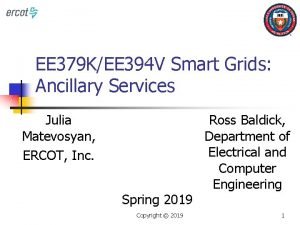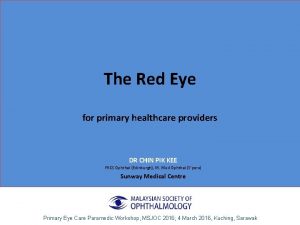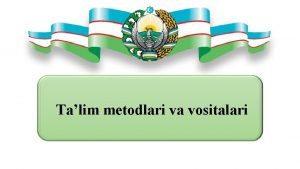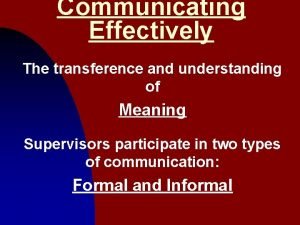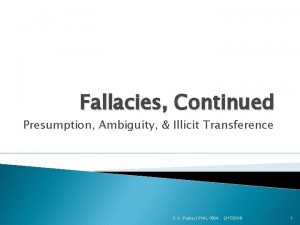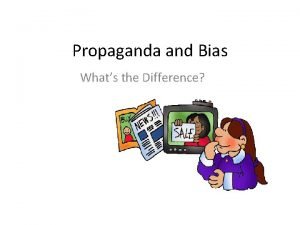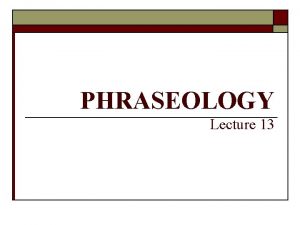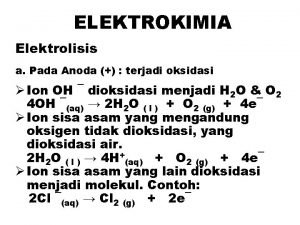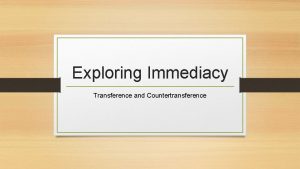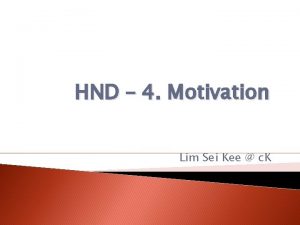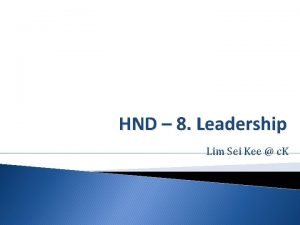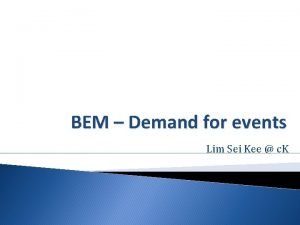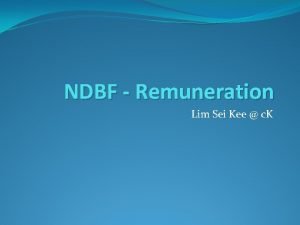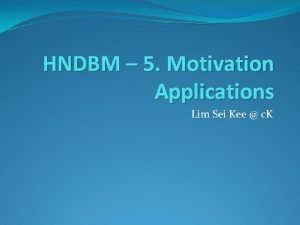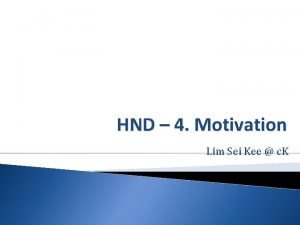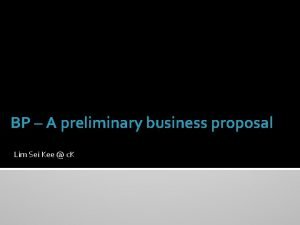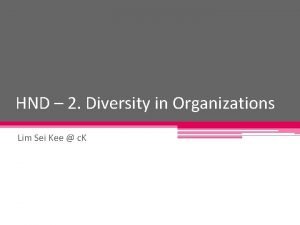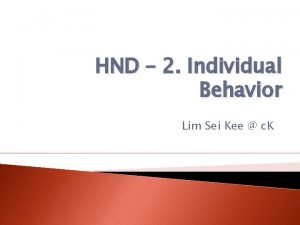Lim Sei Kee c K The transference and





























- Slides: 29

Lim Sei Kee @ c. K

� The transference and understanding of meaning. � Functions: Ø Communication acts to control member behavior in several ways. Ø Communication Ø Provide fosters motivation a release for the emotional expression of feelings Ø It provide the information that individuals and groups need to make decisions

� The steps between a source and a receiver that result in the transference and understanding of meaning. � Key 1. 2. 3. 4. 5. 6. 7. parts – The sender Encoding The message The channel Decoding the receiver Noise feedback

Channel � The medium selected by the sender through which the message travels to the receiver Formal channel – communication channels established by the organization to transmit messages that are related to the professional activities of members. Informal channels – communication channels that are spontaneous and emerge as a response to individual choices.

SENDER Message to be sent Encoding message RECEIVER Channel NOISE Feedback Message received Message decoding

� Downward – flows from one level of a group or organization to a lower level � Upward – flows to a higher level in the group or organization � Lateral – takes place among members of the same work group, among members of work groups at the same level, among managers at the same level

� Oral Communication � Written communication � Nonverbal communication

� Speeches, formal one-on-one and discussion, informal rumor, grapevine � Advantages • § § § group Speed & feedback Response received in a minimal amount of time If unsure, rapid feedback allows for early detection by sender essential for teamwork and group energy. encouraging morale among organizational employees. best used to transfer private and confidential information/matter

Relying only on oral communication may not be sufficient as business communication is formal and very organized. Oral communication is less authentic than written communication as they are informal and not as organized as written communication. Oral communication is time-saving as far as daily interactions are concerned, but in case of meetings, long speeches consume lot of time and are unproductive at times.

Oral communications are not easy to maintain and thus they are unsteady. There may be misunderstandings as the information is not complete and may lack essentials. It requires attentiveness and great receptivity on part of the receivers/audience. Oral communication (such as speeches) is not frequently used as legal records except in investigation work.

� Memos, letters, fax, email, instant messaging, notices, bulletin � Advantages q Tangible and verifiable q Record of communication q Available for future references q For lengthy and complex communication q Well thought, logical and clear q There is a lesser chance for the message to be misunderstood

� Disadvantages q Time consuming q People q No of written communication- may not always read them immediate feedback

�A glance, a stare, a smile, a frown – body movement, the intonations, facial expressions and the physical distance between sender and receiver � Advantages: Ø Supports other communications and provides observable expression of emotions and feelings. � Disadvantage: Ø Misperception of body language or gestures can influence receiver’s interpretation of message

� Formal small-group networks � Grapevine � Computer-Aided communication

� Chain – rigidly follows the formal chain of command � Wheel – relies on a central figure to act as the conduit for all the group’s communication � All-channel – permits all group members to actively communicate with each other

NETWORKS CRITERIA CHAIN WHEEL ALL CHANNEL Moderate Fast High Moderate Emergence of a leader Moderate High None Member satisfaction Moderate Low High Speed Accuracy

� The organization’s informal communication network � Characteristics Ø Not – controlled by the management Ø Perceived Ø Used as being more believable and reliable to serve the self-interests of the people within it

� Advantages§ creates a social bond § The grapevine fills in a gap that is left when official information is missing § helps keep people honest � Disadvantages� information that gets spread through the grapevine is not verified � used to spread more than rumors; it's used to spread gossip � people's reputations, careers, and lives can get destroyed

E-Mail � Advantages: quickly written, sent, and stored; low cost for distribution. � Disadvantages: information overload, lack of emotional content, cold and impersonal. Instant messaging � Advantage: “real time” e-mail transmitted straight to the receiver’s desktop. � Disadvantage: can be intrusive and distracting.

� Intranet �A private organization-wide information network. � Extranet � An information network connecting employees with external suppliers, customers, and strategic partners. � Videoconferencing � An extension of an intranet or extranet that permits face-to -face virtual meetings via video links.

� The amount of information that can be transmitted during a communication episode

Characteristics of Channels Richness 1. Handle multiple cues simultaneously. 2. Facilitate rapid feedback. 3. Are very personal in context.

� Filtering - A sender’s manipulation of information so that it will be seen more favorably by the receiver � Selective perception - People selectively interpret what they see on the basis of their interests, background, experience, and attitudes � Information overload - A condition in which information inflow exceeds an individual’s processing capacity

� Emotions - How a receiver feels at the time a message is received will influence how the message is interpreted � Language - Words have different meanings to different people � Communication Apprehension - Undue tension and anxiety about oral communication, written communication, or both

Men talk to: � Emphasize � Complain � Offer � To status, power, and independence. that women talk on and on. solutions. boast about their accomplishments. Women talk to: � Establish connection and intimacy. � Criticize men for not listening. � Speak of problems to promote closeness. � Express regret and restore balance to a conversation.

Certain words stereotype, intimidate, and insult individuals. In an increasingly diverse workforce, we must be sensitive to how words might offend others. � Removed: handicapped, blind, and elderly � Replaced with: physically challenged, visually impaired, and senior. Removing certain words from the vocabulary makes it harder to communicate accurately. � Removed: death, garbage, quotas, and women. � Replaced with terms: negative patient outcome, postconsumer waste materials, educational equity, and people of gender.

� Cultural Barriers � Semantics � Word connotations � Tone differences � Differences � among perceptions Cultural Guide � Assume differences until similarity is proven. � Emphasize � Practice � Treat description rather than interpretation or evaluation. empathy. your interpretations as a working hypothesis.

� High-Context Cultures - Cultures that rely heavily on nonverbal and subtle situational cues to communication � Low-Context Cultures - Cultures that rely heavily on words to convey meaning in communication.

Highvs. Low-Context Cultures
 Transference meaning
Transference meaning Kee 394
Kee 394 Eric kee
Eric kee Kee 394
Kee 394 Kee 394
Kee 394 Kee 394
Kee 394 Sunisa kee
Sunisa kee Bříza bělokorá
Bříza bělokorá Nažka v číšce
Nažka v číšce Hkfyg lee shau kee primary school
Hkfyg lee shau kee primary school Elmer t kee
Elmer t kee Professor frank kee
Professor frank kee Circumcorneal flush
Circumcorneal flush Dr alan teh kee hean
Dr alan teh kee hean Ta lim metodlari
Ta lim metodlari Amaliy metodlar turlari va tavsifi
Amaliy metodlar turlari va tavsifi Didaktika nima haqida baxs yuritadi
Didaktika nima haqida baxs yuritadi Transference and the understanding of meaning
Transference and the understanding of meaning What is transference
What is transference Transference psychology
Transference psychology Linguistic transference
Linguistic transference Suppressed evidence fallacy
Suppressed evidence fallacy Transference propaganda definition
Transference propaganda definition Types of transference lexicology
Types of transference lexicology Transference propaganda definition
Transference propaganda definition Sel galvani
Sel galvani Uta hagen questions
Uta hagen questions Transference
Transference Testimonial propaganda definition
Testimonial propaganda definition Risk transference
Risk transference





